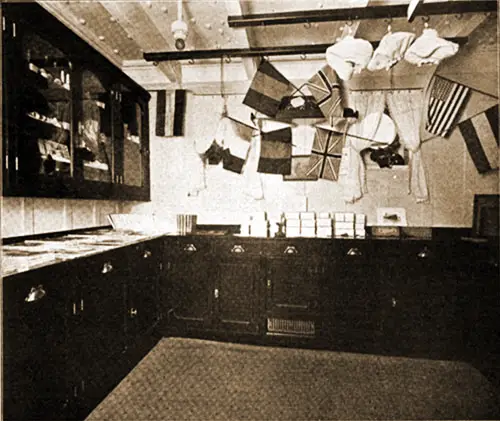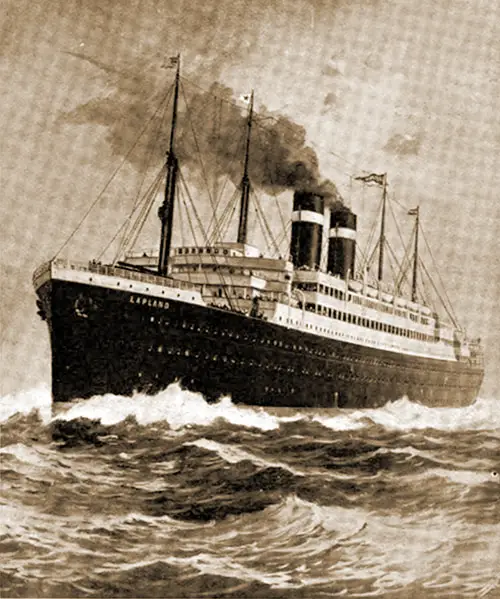Boutique Store on The Steamship "LapLand"

The Little Boutique Shop on Board the Steamship "Lapland" of the Red Star Line, 1909. Men's Wear, 5 May 1909. GGA Image ID # 15ea40a806
When on Saturday, April 24, 1909, the steamship "Lapland" of the Red Star Line made her maiden trip from New York she carried on board Miss Livingston Broom, an American girl, who is the first superintendent of a transatlantic store.
This is the pioneer idea of what may ultimately develop into a profitable and somewhat extensive expansion of the "boutique," or little shop on board the big liners. The little shop is on the shelter deck of this big vessel near the main saloon and admirably situated so that it is readily accessible to the passengers.
It occupies a room about the size of three staterooms. The exterior is in oak and the interior in mahogany and white enamel trim. On four sides of the room there is a mahogany counter containing a series of drawer compartments and closets for the carrying of the different stocks. On the wall there are glazed cabinets, such as are shown in the illustration, for the display of goods also.
Overhead there are a number of mahogany strips equipped with hooks on which garments are hung. In addition to quite an extensive and varied stock of notions for men and women there are the current magazines, latest novels and toilet articles. In the way of wearables the stock also includes sweaters for both sexes, knit Tarn O'Shanter caps for men and women, caps, neckwear, hose, and other dress accessories for men. Miss Broom also types.

The New Twin-Screw Steamer "Lapland" of the Red Star Line. 18,694 Tons; 620 Feet Long; 70 Foot Beam. Men's Wear, 5 May 1909. GGA Image ID # 15ea4c8102
Unfortunately at the time the photograph of the little shop was taken Miss Broom did not have her stock on display, as it was two days before the boat sailed. On the afternoon of the day before sailing Miss Broom arranged all her stock so that it was out in view, and the shop then had the appearance of a well-stocked department and was ready to serve all comers.
As this was the first trip from New York Miss Broom has yet to become more thoroughly acquainted with what the wants of passengers are before laying in a more varied and comprehensive stock of goods, and this can be developed as experience and demand warrants.
This first venture of the department store on board ship, it must be understood, is but the beginning, and is only an individual effort. It is a project that can be greatly developed, even in the rather limited space that can be given to it. on transatlantic liners.
The idea of silent salesmen showcases, cabinets for carrying garments, and the other styles of fixtures now in current use in the retail stores for the expeditious handling of merchandise and condensing the stock into limited area for carrying and displaying, have not been thought of in this case.
The project will, for greater development, require the experience and judgment of a merchant. It is a proposition that is yet open to any large and representative department store organization.
There is no doubt that if such a house took up the matter of Installing little shops on all the big transatlantic liners, fitting them out with fixtures especially designed and adapted to the handling of merchandise in a limited space, placing such shops in charge of a competent saleswoman who has store experience and knows how to sell goods and to study and meet the demands of the patronage.
The idea of maintaining little shops on board ships plying between this and other American ports and the Continent, that a business extensive enough in the aggregate could be done, and that the volume of the output would be big enough to make the undertaking of it extremely profitable and therefore well worth while for the outlay that would be necessary.
There is one thing self-evident, and that is the rather small expense of maintaining such a series of small shops on the different vessels. As a matter of course, if one little shop pays one woman who makes no claim to being an expert businesswoman and pays a most satisfactory profit.
There should be a handsome profit in the operation of a number of such little shops by an organization that is well equipped and in position to undertake it in a way that would be productive of the best service.
And Miss Broom told a representative of this magazine that notwithstanding her maiden trip from Antwerp was made with a rather small number of passengers on board, it was a very profitable and satisfactory "opening."
The Lapland left New York with a large passenger list, and one that contained many notable persons. It is therefore a foregone conclusion that the first trip from this port will prove a very much better one for her business.
But apropos of the foregoing suggestion that there is in this pioneer little shop a new field for the department store to enter, this magazine is reliably informed by a person speaking with authority that the International Mercantile Marine Company would receive overtures from any representative firm desirous of furthering project.
Since certain of the transatlantic liners have been equipped with wireless telegraph apparatus it has become quite a fad for passengers to send wireless messages to friends while en route on the ocean. In this connection the scheme of a shop on board ship brings up the proposition that eventually it might be possible for some live merchant having different branches to also create the fad for ordering by wireless while in transit certain articles to be sent direct from such branch stores to friends.
Such a project, of course, might be made wholly feasible and interesting if the business advertised that orders by wireless made through responsible people would have the best of attention and service.
Interest in the idea could also be created by making known to the public that deliveries would be made in special boxes and wrap pings that would indicate that they were wireless orders, thus enhancing to the recipient the value of the compliment from the Everybody who goes abroad receives, as presents from friends, books, flowers and what not, and what better way for them to return such compliments than by wireless orders to known and representative stores?
Twenty-seven of the transatlantic liners now issue a daily paper on board ship in magazine form, part of which is printed on shore, and to which is added pages prepared and printed in the miniature newspaper plants on the vessels, and contains the news received daily by wireless, consisting also of the principal happenings on the ship itself, which newspapers are bound in on ship with the sections printed on shore.
The latter contain front cover design, several articles of general interest, short stories, and book, opera and theater reviews, all of which are changed daily on the voyage. Here again is another commercial possibility presented to the smart merchant, as through advertising in "The Atlantic Daily News" there would be opened up new channels for the distribution of merchandise, and such publicity used in connection with the department store on shipboard and filling wireless orders for goods ought to open up great opportunities for business.
"A New Field Open For The Department Store," in Men's Wear: The Retailers' Newspaper, New York-Chicago: Fairchild Company, Vol. 27. No. 1, 5 May 1909: 58-59
